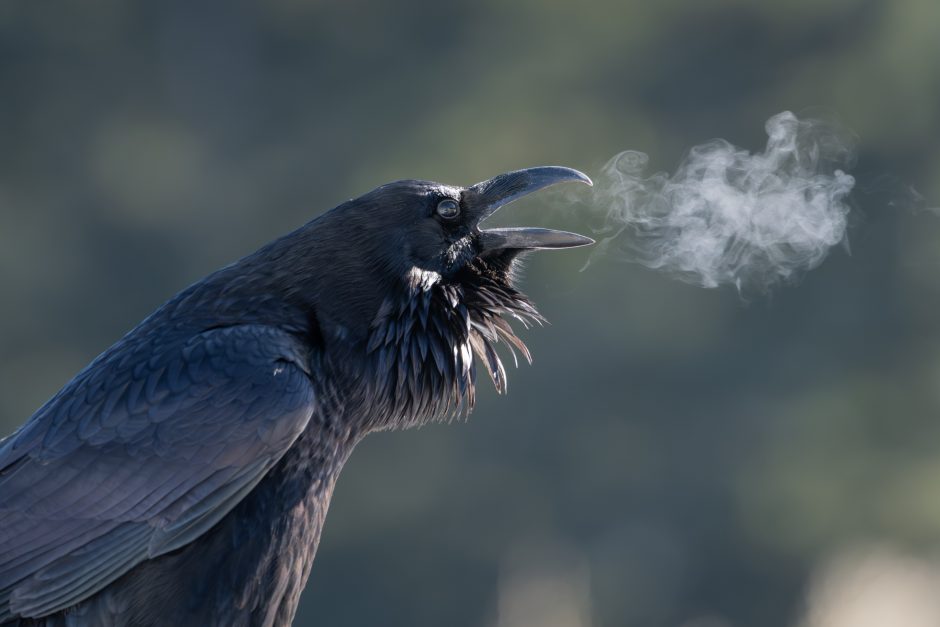
How to Get this Shot: Raven’s Breath in Yellowstone
Photographing wildlife in extreme conditions can yield breathtaking results, both figuratively and literally. My image above, what I’ve named Raven’s Breath, was taken in Yellowstone National Park in the heart of winter. The photo captures a raven with its visible breath curling into the icy morning air as it called out. It’s one of those magical moments that brings together preparation, patience, and to be honest, a bit of luck. Here’s the story of how I got the shot, along with tips to capture your own “breathtaking” image.
To set the scene; it was a cold January day in Yellowstone, and the temperature hovered at 24°F (-4°C). Winter is one of the most incredible times to visit the park. The crowds are gone, snow blankets the landscape, and wildlife behavior shifts with the colder weather. Ravens are active year-round and are particularly striking against the stark white backdrop of winter.
Finding the Raven
This is the easy part. Ravens are quite common in Yellowstone, often seen around geysers, carcasses, or visitor areas where they can scavenge. As I traverse the park looking for the bigger, charismatic wildlife like bison and wolves, I always keep eye out for the ravens in case I see a great composition or behavior. (To let you in on a little secret, this particular raven was in a gas station parking lot in the national park and perched atop a dumpster. Ahh the magic of zooming in).
Ravens are highly vocal birds with a wide range of calls. As I watched, I noticed this particular raven had settled into a routine of croaking every few minutes, pausing to look around in between. The weather was just cold enough to freeze my breath and the raven’s. The conditions and its predictable behavior allowed me to anticipate its movements and vocalizations, so I could set up for the image next time it called.
Gear and Settings
To get this shot, I used:
- Gear
- Camera: A full-frame DSLR
- Lens: 200-500mm zoom lens
- Settings:
- Focal Length: 500mm
- Aperture: f/7.1
- Shutter Speed: 1/800 sec
- ISO: 1600
Why These Settings?
Lens Choice: The 500mm lens allowed me to shoot from a distance, minimizing disturbance to the raven so it would continue calling normally and predictably.
Aperture f/7.1: This aperture struck a balance between isolating the subject from the background (with some beautiful pine forest bokeh) and maintaining enough depth of field to keep the raven and its breath in focus.
Shutter Speed 1/800 sec: Ravens are rarely still for long. Their movements, combined with the slight breeze that could disperse the breath quickly, necessitated a faster shutter speed to freeze the action.
ISO 1600: The low morning light required a higher ISO to maintain a fast enough shutter speed. Modern cameras handle noise well at ISO 1600, especially if you shoot in RAW and apply noise reduction in post-processing.
Capturing the Breath
Photographing the visible breath of an animal is both an art and a science. Here are the critical factors:
Weather Conditions: Breath is most visible in cold, moist air. At 24°F, the warm exhalations of the raven can more easily condense into a cloud of mist. That combined with the stillness of the morning ensured the breath lingered long enough to be photographed.
Timing: Timing is everything when photographing behavior like vocalizing. I observed the raven for several minutes, finger on the shutter button, waiting for the moment it opened its beak.
Backlighting: The soft backlight of the morning sun illuminated the breath, creating a dramatic effect. Positioning yourself relative to the light is crucial; a slight angle helped emphasize the texture and shape of the mist.
Burst Mode: The most important thing you can do is take a lot of shots. This will maximize your chances of capturing the perfect moment; the cloud of breath is still consolidated, out of the beak, and a swirl or two are visible as it mixes with the surrounding air.
Final Thoughts
Raven’s Breath is a photo that reflects both the beauty of winter and the magic of Yellowstone. It’s a reminder that incredible moments are often just a shutter click away if you’re willing to put in the time and effort. Whether you’re chasing ravens, wolves, or other wildlife, keep experimenting and learning from every shoot. The next time you find yourself in a cold, quiet landscape, listen for the call of a raven. You might just capture your own moment of magic.
Happy Photographing,

Leave a reply